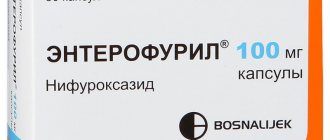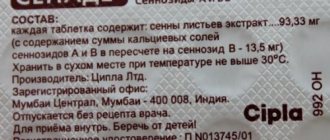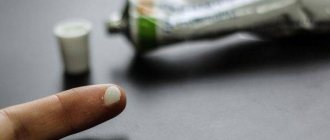Levomycetin actitab for diarrhea
The rhythm of our daily lives often leaves no time for eating. People eat on the go and do not pay attention to food hygiene, which leads to digestive disorders. The most common disorder is diarrhea. People know a popular remedy that eliminates intestinal disorders - "Levomycetin", but the unpleasant bitter taste forces them to look for an alternative. Levomycetin Actitab, a drug that helps quickly eliminate intestinal infections, is presented on the modern pharmacological market.
Can children take it and how?
You can take Levomycetin in childhood (starting from the 1st-2nd month of life), but in order to avoid negative reactions, treatment must be coordinated with a pediatrician. Here are approximate dosages:
- For children under 3 years of age, it is recommended to take the antibiotic 15 mg per 1 kg of weight 3-4 times a day (with the same time interval).
- Children over 3 years old and weighing more than 20 kg are given the drug 25 mg every 6 hours. But in case of severe poisoning and intestinal infections, the daily dose can be increased to 100 mg per day (only with the permission of the attending physician).
Advice! The usual drug has a bitter taste that is unpleasant for children, so the child may refuse to take it (because the bitterness makes the tablet difficult to swallow). In this case, instead of the traditional remedy, you can use Levomycetin Actitab - it has a neutral taste, but is not inferior in effectiveness to the standard drug.
The course of treatment is 1-2 weeks. If the symptoms of diarrhea go away faster, the dosage can be reduced slightly (under the guidance of a specialist), but therapy must be continued to the end.
Use of the drug for diarrhea
Despite the composition being identical to Levomycetin, Levomycetin Actitab works more effectively against an expanded list of pathogenic microbes that cause infectious and inflammatory diseases. As an antibiotic with a wide range of uses, it is prescribed to eliminate infectious and inflammatory processes of varying severity. Timely intake helps to get rid of nausea, vomiting, flatulence, diarrhea, and inflammatory processes. Many patients note a positive result with loose stools even after a single dose.
Indications for use
The drug is prescribed primarily for infectious diseases of the biliary tract and genitourinary system caused by the presence of pathogenic microorganisms. The medicine is often prescribed for diseases of this kind:
The drug is used to treat diarrhea. Taking it as a remedy for diarrhea is possible in the following cases:
- Poisoning, accompanied by diarrhea and vomiting, when gastric lavage does not produce results.
- Feces containing blood or pus.
- With diarrhea accompanied by an increase in body temperature.
- Intolerance to other antibiotics.
In addition to the above cases, Levomycetin Actitab is used in ophthalmology as an integral component of a set of measures for the treatment of inflammatory eye diseases.
It is recommended to take the drug after identifying the pathogen that caused the diarrhea. Sometimes you have to wait a long time for the culture test to be ready, showing a microorganism sensitive to a particular antibiotic, so doctors have the right to prescribe the use of antibiotics with a broad spectrum of action.
Interesting fact: the medication is approved to eliminate diarrhea in animals. To select the correct dosage, contact your veterinarian so as not to harm your pet’s health.
About the properties of the drug
The agent in question is a broad-spectrum antibiotic that effectively affects a number of infectious diseases. Medicine against diarrhea caused by bacteria is also suitable.
The active ingredient of this product, chloramphenicol, has a bacteriostatic effect on pathogenic microorganisms, inhibiting protein synthesis in their cells. Complete absorption of Levomycetin into the blood occurs within 3 hours and remains there for up to 5 hours. So the effect of the drug can be felt after taking one tablet.
The drug does not settle in the tissues of the patient’s body - it is completely excreted in the urine and partially in feces and bile. But with prolonged use, Levomycetin causes dehydration of the body. The bacteria themselves become accustomed to the drug slowly, which makes it possible to successfully complete a course of therapy for diarrhea.
Instructions for use
The drug, which comes in tablet form, is taken orally. The tablet should be swallowed whole, washed down with plenty of warm water. The standard dosage of Levomycetin Actitab for adults is two hundred to two hundred and fifty milligrams, the dose per day does not exceed two grams. It is better to organize taking tablets three to four times a day before meals. In cases of nausea, it is better to postpone the use of the medicine for an hour and take it after meals. Increasing the dosage is permitted only under medical supervision and control of tests in a hospital setting.
Children over three years of age are prescribed one hundred and twenty-five milligrams. The dosage recommended for use by children is twelve and a half milligrams of the medicine every six hours or twenty-five milligrams every twelve hours. The exact dosage and duration of treatment is selected exclusively by the doctor, assessing the child’s condition, weight, and age.
Taking the drug correctly
We have already figured out that exceeding the dosage and uncontrolled use of the drug can end very sadly. This is why the doctor should tell the patient how to take Levomycetin for diarrhea, based on the age, condition and weight of the sick person. However, it happens that leaflets with prescriptions are lost, and it is for such cases that we will tell you how to take Levomycetin tablets for diarrhea.
What you need to know
- Treatment with this antibiotic will help if it is started within the first hours (maximum, 24 hours) after the onset of symptoms of diarrhea
- A very important condition for therapy with this medicine is taking the drug at regular intervals.
- Typically, a course of antibiotic treatment lasts from five days to two weeks. However, if the diarrhea ends earlier, the dosage of the antibiotic can be reduced. Of course, this aspect is agreed upon with the attending physician.
For adults
Adults take the medicine one tablet every five to six hours. The maximum effect will be achieved if treatment occurs one hour before or two hours after meals (the food rule applies to all antibacterial drugs that you will have to deal with). For mild forms of diarrhea, the dosage of the active substance in one tablet should be a quarter of a gram, for severe conditions - half a gram. The daily maximum is 4 grams of active ingredient.
For children
The dosage of chloramphenicol for diarrhea in children is calculated based on the weight and age of the baby. If the child is over three years old and weighs more than twenty kilograms, he takes 12.5 mg of antibiotic every six hours, or 25 mg every twelve hours. If the disease is severe, the dosage is increased to 75 mg. But in this case, constant monitoring must be carried out over the condition of the child’s kidneys and liver, as well as over the concentration of the active substance in the blood.
Contraindications
Do not forget that this is an antibiotic, and quite a powerful one; you should not take it yourself, without a doctor’s prescription. Like any medical product, the medicine is accompanied by a number of cases that do not allow its use:
- The drug is not recommended for use if the patient has kidney or liver dysfunction.
- Diseases of the hematopoietic organs.
- Pre-diagnosed acute intermittent porphyria.
- Intolerance or sensitivity to any component of the drug.
- The presence of certain skin diseases - eczema, psoriasis, mycosis, fungal infections.
- The medicine is not suitable for use by young children under three years of age and weighing less than twenty kilograms (a “gray syndrome” may occur - a phenomenon when individual components accumulate in the child’s body due to the inability of the liver to cope with them and have a toxic effect on the child heart).
- Pregnant and breastfeeding women should avoid using the medicine.
If diarrhea is caused by a chronic illness, the tablets will be ineffective. If diarrhea lasts more than one day, the drug is not used. It is not recommended for use by people who have previously been treated with cytotoxic drugs or have undergone radiation. The use of the drug is not prohibited, the course of treatment is carried out under the strict supervision of the attending physicians.
Methods of application
According to the instructions for use, it is advisable to drink the antibacterial agent no earlier than 30 minutes before meals. A gastroenterologist will help you figure out the correct dosage.
Recommended approximate doses of the drug for adults:
- For diarrhea, intoxication, bacterial infections of the urinary tract, gastrointestinal tract : 1 tablet/capsule 3-4 times a day. It is permissible to use different concentrations of the active substance in tablets - 500 or 250 mg.
- For meningitis, bacteremia, and other severe infections : you need to take Levomycetin 2 tablets (500 mg each) 4 times a day.
Important! The decision to increase the dosage is made by the doctor. You cannot voluntarily start taking a double dose, focusing only on personal feelings.
An antibiotic in tablet form is prescribed to children from the age of three. From the age of 7, young patients can take capsules. It is permissible to use Levomycetin in newborns from two weeks of age - but during hospitalization of the patient.
Antibiotic therapy in tablet form is carried out only in those young patients whose body weight is at least 20 kg. Patients are given half a tablet (250 mg) 3-4 times a day. In children, the concentration of the active component in the blood must be laboratory controlled.
The duration of treatment depends on the type of pathology and the characteristics of the disease. The average duration of therapy is from 1 week to 10 days.
Side effects
When taking the drug, side effects may occur. In the area of the digestive system, dysbiosis, irritation of the mucous membranes of the mouth and pharynx, diarrhea, constipation, nausea, and vomiting occur. The nervous system may respond with clouding of consciousness, depression, migraines, hallucinations, decreased hearing and vision, and acute headache.
Possible disturbances in the hematopoietic function. An allergic reaction is likely to occur in the form of swelling and rashes on the skin.
Interaction with other drugs
"Levomycetin Actitab" is sold only with a doctor's prescription. Self-medication with drugs is unacceptable; it can lead to dire consequences, including death.
You should be careful when using antibiotics together with other medications. The simultaneous use of phenobarbital and chloramphenicol slows down the elimination of the antibiotic. You should not combine chloramphenicol and drugs such as erythromycin - the effectiveness of action is significantly reduced.
It is prohibited to use it together with alcohol-containing drugs, be it an alcoholic drink or a medicine based on ethyl alcohol. A common result of this combination is severe headaches, red skin, cramps and painful sensations in the epigastrium. Taking antibiotics and alcohol together leads to pressure drops, shortness of breath, and increased heart rate.
For every negative review about Levomycetin Actitab, there are a dozen positive ones - a sufficient indicator of the fact that the medicine is effective in treating mild intestinal disorders if you carefully follow the recommendations. A single use of the drug is enough to “strengthen” the intestines. Along with the elimination of diarrhea, people note a significant decrease in pain in the stomach and a decrease in discomfort in the abdomen. Many doctors and pharmacists recommend purchasing this medicine for your home medicine cabinet. This advice is especially relevant for the warm season, at the height of the season of vegetables, berries, and fruits. These fruits can cause diarrhea, especially when it is not possible to wash them thoroughly, because in summer pathogenic bacteria and microbes develop faster.
The use of Levomycetin Actitab is only possible to eliminate uncomplicated diarrhea. If a day of use does not bring improvement, it is recommended to consult a doctor to find out the reasons that caused the intestinal dysfunction. More detailed diagnostics and the prescription of other medications will likely be required. It is important to drink more fluids to avoid dehydration.
Before using any medicine, you must consult with your doctor and carefully study the instructions for use!
source
Does Levomycetin help with diarrhea + how to take it + what to replace it with + the best new drugs
Levomycetin ® is an antibacterial agent that has a wide spectrum of bacteriostatic effects, realized through active inhibition of peptidyl transferase and disruption of the process of protein synthesis by bacterial cells. Staphylococci, streptococci, pneumococci, enterococci, E. coli, Haemophilus influenzae, salmonella, shigella, klebsiella, serracia, yersinia, proteus, gono- and meningococci, rickettsia, spirochetes, shigella, chlamydia are sensitive to the drug. Content:
The drug can be used to treat infections caused by strains of bacteria resistant to penicillin, streptomycin and sulfonamides.
It should also be noted that the antibiotic has rapid and complete absorption in the gastrointestinal tract and high bioavailability when taken orally.
How to take chloramphenicol ® correctly for diarrhea?
Due to the effectiveness of the drug against many pathogens of acute intestinal infections (AEI), chloramphenicol was previously used quite often for diarrhea in adults, however, at present, it is practically not used for AEI.
This is due to two main reasons. Firstly, despite the widespread myths in everyday life about its harmlessness, chloramphenicol is a rather toxic antibiotic. Treatment with this drug often leads to the development of undesirable effects, in particular, the drug inhibits the hematopoietic function of the bone marrow.
Secondly, due to the frequent self-medication of patients with chloramphenicol tablets for diarrhea, many strains of bacteria have acquired resistance to this drug.
Taking chloramphenicol actitab for diarrhea has long been considered an extremely popular method of treatment, but many patients preferred not only to prescribe the antibiotic themselves, but also to take it incorrectly, drinking chloramphenicol for 1-2 days and stopping taking it.
It should also be noted that most acute intestinal infections are of viral etiology, so taking chloramphenicol for children and adults with diarrhea may not only be inappropriate, but also dangerous. While taking antibiotics, the normal intestinal microflora is inhibited, therefore, with a viral acute intestinal infection, chloramphenicol can only worsen the patient’s condition.
Answering the question: does chloramphenicol actitab help with diarrhea, it should be noted that the antibiotic can still be used for a generalized form of salmonellosis or for shigellosis caused by Shigella Sonne. However, even in this case, chloramphenicol is not the drug of choice and should be used only after obtaining cultures for the sensitivity of the pathogen to the antibiotic. Prescribing chloramphenicol will be advisable only if the sensitivity of salmonella or shigella to it exceeds the sensitivity to other antibacterial agents.
Can it be used during pregnancy and how?
The use of antibiotics during pregnancy is of great concern. And this is not surprising, because drugs of this group have a systemic effect on the body (including affecting the fetus in the womb). What to do in the case of Levomycetin? Is it worth taking it?
According to the instructions for the drug, the use of Levomycetin during pregnancy is strictly contraindicated (in any trimester). Otherwise, negative consequences for the child are inevitable, for example:
- Pathologies of development of various systems of the child’s body (including encephalopathy - brain damage).
- Organic lesions incompatible with life.
- Intrauterine fetal death (especially when taking an antibiotic in early pregnancy).
Therefore, to preserve the life and health of the child, it is not recommended to use Levomycetin during pregnancy.
How can I replace chloramphenicol ®?
It is important to understand that the use of antibiotics for acute intestinal infections, as for any other diseases, must be justified. Antibacterial therapy is mandatory for bloody type diarrhea (that is, diarrhea is accompanied by the release of bloody mucus or streaks of blood) and for cholera (secretory type diarrhea).
Antibacterial therapy is also advisable for high (uncontrollable within 24 hours) fever, severe diarrhea, severe acute intestinal infections (caused by Shigella, Salmonella or Escherichia), complicated salmonellosis, as well as acute intestinal infections in patients with immunodeficiency conditions.
If you have severe diarrhea, severe abdominal pain, fever and dehydration, call an ambulance immediately. A mandatory indication for emergency hospitalization is the patient's age under three years. The fact is that young children develop severe dehydration extremely quickly, leading to a decrease in circulating blood volume, blood thickening, electrolyte imbalance, kidney dysfunction, etc.
Attempts to independently treat children in the first years of life are extremely dangerous and can lead to death.
What antibiotics can be used to treat intestinal infections?
According to indications, the following can be used:
Alpha Normix ® for intestinal infections
- fluoroquinolones (ciprofloxacin ® , ofloxacin ® , norfloxacin ® );
- ampicillin ®;
- doxycycline ® .
It is necessary to understand that the choice of antibiotic will depend on the pathogen, its sensitivity to the drug and the severity of the patient’s condition. Antibiotics must be prescribed by the attending physician.
Currently, intestinal antiseptics are often used. Recommended use:
- Intestopana ® ;
- Intetrix ® ;
- Nifuroxazide ® ;
- Enterosediva ® .
Substitutes
If an intestinal infection bothers you, and you cannot take this antibiotic due to contraindications, the doctor will prescribe another medicine from the list indicated in the table.
| Name | Short description | Contraindications |
| Ofloxacin | A relatively inexpensive drug, similar to Levomycetin in its effect on bacteria. Efficiency is 96%. When taken with food, the absorption of the drug slows down. | Individual intolerance, age under 16 years, pregnancy, breastfeeding. |
| Nystatin | It belongs to the antifungal group, but also has an effect on pathogenic bacteria. | Peptic ulcer, pancreatitis, sensitivity to the drug, liver dysfunction, pregnancy, lactation. |
| Macropen | Powerful antibacterial drug. The effect is observed after an hour and a half. | Hypersensitivity to the components of the composition, severe forms of liver failure, pregnancy, breastfeeding. |
| Vilprafen | From the group of bacteriostatic macrolides. It is even prescribed to infants - the drug with the prefix Solubat has a strawberry flavor. | |
| Tetracycline | A powerful but inexpensive remedy. It is a broad-spectrum antibiotic, but with prolonged use it can accumulate in the body. | Children under 8 years of age, nursing and pregnant women, patients with kidney and liver problems. |
Levomycetin has other substitutes, but the use of each of them must be approved by the attending physician. Because antibiotics are more or less toxic to humans, and an incorrectly selected dosage will do more harm than good.
Sorbents
The use of sorbents for intestinal infections is mandatory. These drugs are capable of binding and removing from the body exogenous and endogenous toxins, endotoxins produced by bacteria, toxic protein breakdown products, allergens of food and bacterial origin.
- Smecty ® ;
- Lactofiltrum ® ;
- Enterosgel ® ;
- Activated carbon ® ;
- Carbolonga ® ;
- Atoksila ® ;
- Polysorba ® ;
- Orbexa ® ;
- Polyphepane ® .
Levomycetin for children
Treatment with Levomycetin is justified; the drug should be given to children with caution and only as prescribed by a doctor. In pediatrics, it is not recommended to take the drug for mild forms of bacterial infection. If a child needs to take an antibiotic, doctors are more often inclined to prescribe erythromycin and only in rare cases can they prescribe Levomycetin.
Levomycetin is prescribed to children over 3 years of age. The initial dose of the drug should not exceed 125 mg 2 – 3 times a day. For adolescents, the dose may be increased to 250 mg 2 times a day. Only a doctor can adjust the dose to a child, as well as prescribe the drug itself, after the results of the examination and identification of the pathogenic pathogen.
For some adults, Levomycetin Actitab or regular one is the first aid for diarrhea, so they no doubt use it for children. It is important to note that Levomycetin is a fairly strong antibiotic, so for minor stool disorders, it is better to use safer and more effective medications: Nifuroxazide, Enterol, which are intended for intestinal infections accompanied by loose stools.
Eubiotics for diarrhea
For mild secretory (watery) diarrhea, eubiotic preparations are used:
- Enterozermina ® ;
- Hilak ® ;
- Linex ®;
- Acipol ® ;
- Symbiter ® acidophilus;
- Baktisubtil ®.
These drugs help restore normal intestinal microflora, normalize the body's natural resistance, restore local immunity, and activate the work of specific and nonspecific immunity.
Also, beneficial bacteria contained in eubiotics (probiotics) are able to regulate the digestive function of the gastrointestinal tract, restore parietal absorption in the intestine, synthesize vitamins K and B, and restore the process of absorption of electrolytes.
For intestinal infections and severe dysbiosis with activation of opportunistic microorganisms, these drugs act as antagonists of pathogenic and opportunistic bacteria, disrupting their growth, reproduction and activity.
source
The effectiveness of Levomycetin for diarrhea
Levomycetin for diarrhea is used if stool disorder is caused by the activity of pathogenic bacteria:
- salmonella;
- shigella;
- streptococci;
- some staphylococci;
- chlamydia;
- pseudomonas;
- Proteus and a number of others.
But this antibiotic is powerless against clostridia, Pseudomonas aeruginosa, strains of staphylococci resistant to methicillin, protozoa, fungi and acid-fast bacteria.
Once in the body, Levomycetin is concentrated mainly in the liver and kidneys, but is also present in bile and cerebrospinal fluid. The kidneys and gastrointestinal tract are involved in excretion, which causes possible side effects.
Despite the fact that Levomycetin is a potent antibiotic, it helps with diarrhea only indirectly, destroying the causative agents of the disease. Levomycetin does not have an astringent effect during diarrhea, does not slow down intestinal motility or the production of enzymes in the stomach, and does not have any other properties that could somehow affect the course of diarrhea.
Levomycetin is not used for poisoning. The action of a bacteriostatic antibiotic is aimed at destroying the cells of pathogenic bacteria. It does not affect toxins, heavy metal salts, or radionuclides that cause poisoning.
It is worth distinguishing between an intestinal infection and food poisoning. The symptoms of these pathologies are similar; OCI can also occur after consuming certain foods that contain pathogens. Like food poisoning, the infection is accompanied by diarrhea, vomiting, diarrhea, and fever. But the deterioration of the patient’s condition is caused by the activity of pathogenic microorganisms, and not by the poisons contained in the food.
For enteroviral infections (the so-called “intestinal flu”), Levomycetin is also not prescribed. Its action is aimed only at bacterial cells; This remedy has no effect on viruses.
Composition and release form
Light yellow tablets have a cylindrical shape. They contain the active element floratfenicol. It refers to antibiotics that block the production of microbial proteins and disrupt their integrity.
Excipients include:
- calcium stearate,
- potato starch,
- polyvinylpyrrolidone.
Thanks to the activity of the components, the distribution of the active substance in the body and its absorption into the stomach accelerates.
After two hours, the maximum concentration of Levomycetin in the blood can be noted. The drug enters the tissues, fluids, organs of the body, as well as breast milk and cerebrospinal fluid.
Dosage regimen and dosage for diarrhea
The most common dosage form of Levomycetin is tablets of 250 and 500 mg. There is also a new generation drug on sale - Levomycetin Actitab. It has the same chemical formula, but due to the nature of its production, it is active against a larger number of pathogenic microorganisms. In addition, Levomycetin Actitab for diarrhea can be given to children starting from 3 years of age.
For an adult with diarrhea
The total duration of antibiotic therapy is 8–10 days. Subsequently, resistance of pathogenic microorganisms to chloramphenicol begins to develop. If during this period the drug did not work for diarrhea, the therapy was selected incorrectly.
A single dosage for diarrhea for adults is 250–500 mg. During the day, the total dose should not exceed 2 thousand mg if the patient is treated on an outpatient basis. In a hospital, under the supervision of a doctor, it can be increased to 3000–4000 mg.
For a child with diarrhea
Levomycetin for children with diarrhea is prescribed only by the decision of a pediatrician or infectious disease doctor. Antibiotic therapy is advisable if the side effects from its use will cause less harm to the child’s health than the absence of treatment. As a rule, it is used for severe forms of infectious diseases.
In pediatrics, the dosage of the drug for diarrhea is regulated taking into account the concentration of chloramphenicol in the blood. It should not exceed 12.5 mg/kg of the child’s weight if the medicine is taken every 6 hours. If the total daily dose is divided into only 2 doses, the maximum concentration is calculated within 25 mg/kg. In case of severe infection, it is permissible to increase the dosage to 75–100 mg/kg under the supervision of medical personnel.
Antibiotics for diarrhea are allowed from 12 years of age; earlier use is permitted only for health reasons. Due to the fact that chloramphenicol is processed in the liver, and in newborn infants and premature babies it is not sufficiently developed, there is a risk of developing the so-called. gray syndrome. It is manifested by a change in skin tone to bluish-gray, a decrease in body temperature, and cardiovascular failure. The mortality rate of this syndrome can reach 40%.
Composition of chloramphenicol tablets actitab
The main active ingredient providing a therapeutic effect is chloramphenicol.
This is a broad-spectrum antibacterial agent that has a pronounced bitter taste. Insoluble in water, but soluble in alcohol. The substance has high activity against gram-positive and gram-negative bacteria and their strains, chlamydia and other microbes. Once inside the body, the antibiotic disrupts the life processes inside the cell. Resistance to the drug develops very slowly.
Additional components:
- silicon dioxide is an enterosorbent that removes toxins from the body;
- povidone is a detoxifying agent;
- crospovidone is a chemical compound that promotes the release of the active substance from the tablet;
- calcium stearate – stabilizer;
- cellulose - to create a protective shell for tablets and ensure prolonged action;
- macrogol is a polymer that improves intestinal motility;
- titanium dioxide – a filler for tablets that gives a white color;
- iron oxides (black, red, yellow) – food coloring;
- aluminum varnish – food additive, synthetic dye;
- talc is an auxiliary substance for the production of tablets.
Levomycetin actitab is produced in the form of tablets for oral administration. Each tablet is coated with a special film of a light blue hue. In appearance they are oblong in shape, with graphene in the middle. In a cross section, two layers are clearly demarcated. The inside of the tablet is white or with a yellow tint.
The dosage of the dosage form is 250 and 500 mg. One aluminum foil blister contains 10, 12 and 15 tablets. One cardboard box contains from 1 to 6 blisters and instructions for use. Tablets are stored at room temperature not exceeding 25°C, away from sunlight.
Dosage regimens
The drug is taken orally half an hour before meals. The number of appointments is from 2 to 4, depending on the diagnosis. The maximum daily dose of an antibiotic should not exceed 2 g. If the patient is seriously ill and is in hospital treatment, the dosage can be increased to 4 g per day. At the same time, he must be under constant supervision.
Chloramphenicol is prescribed to children from 3 years of age and only if their body weight is at least 20 kg. Young patients are prescribed tablets containing the active substance 250 mg or 0.25 g. Give 1 tablet every 12 hours or ½ tablet. every 6 hours. If a child has a severe infection, the maximum daily dose may be increased to 100 mg per kg of weight to help him. At the same time, constant monitoring of the concentration of the substance in the blood plasma is carried out.
The duration of the antibacterial course is 8-10 days.
For diarrhea, the maximum course of treatment is 7 days. If there are blood impurities in the stool, then the antibiotic continues to be taken for 15 days.
Levomycetin actitab, when taken orally, is instantly absorbed into the bloodstream through the gastrointestinal mucosa. Its highest concentration in blood plasma is observed after 2-3 hours. The active effect of the drug in the blood lasts for 4-5 hours. The antibiotic easily penetrates into all liquid media and tissues of the body.
The percentage of chloramphenicol content in the body after administration;
- blood plasma – from 45 to 90%;
- cerebrospinal fluid – from 20 to 50%;
- bile – 30%;
- fetal blood serum during intrauterine development – from 30 to 80%;
- liver – 90%.
Levomycetin is active against the following microbes:
- salmonella;
- shigella;
- Escherichia;
- Proteas and their strains;
- pathogens of meningitis;
- treponema;
- Klebsiella
The antibiotic has no effect on bacteria that are resistant in an acidic environment - staphylococci, enterobacteria, fungi, protozoa.
The drug is excreted from the body within 24 hours by the kidneys (90%), naturally through the intestines (1-3%). During hemodialysis, it is excreted very poorly.
The use of chloramphenicol is effective for infectious diseases of the digestive, urinary and other systems. Levomycetin actitab helps against inflammatory pathologies caused by bacteria that are sensitive to chloramphenicol:
- intestinal infections - dysentery, typhoid and typhus;
- infectious brain damage - whooping cough, meningitis;
- damage to the lymphatic system - tularemia;
- respiratory system infections - pneumonia;
- infectious inflammation of the urinary system - pyelonephritis, chlamydia, cystitis;
- generalized infections – sepsis.
Levomycetin actitab is often prescribed for diarrhea. Tablets in a short time allow you to get rid of symptoms such as loose stools, intestinal upset in the form of putrefactive and fermentative processes (dyspepsia), and flatulence.
Contraindications for diarrhea
The antibiotic is contraindicated in children under 12 years of age, pregnant and lactating women, as well as in the presence of certain diseases:
- chronic renal and liver failure;
- acute intermittent porphyria;
- inhibition of bone marrow hematopoiesis;
- glucose 6-phosphate dehydrogenase deficiency;
- dermatological diseases, including eczema, mycoses and psoriasis.
Contraindications also include hypersensitivity to chloramphenicol or auxiliary components. During the course of antibiotic therapy, it is recommended to refrain from driving vehicles and complex mechanisms due to possible disruption of the central nervous system.
If the patient has recently been treated with cytotoxic drugs or radiation therapy, the use of Levomycetin is undesirable, but is possible according to the doctor’s decision.
Possible side effects include:
- Allergic reactions. The most common are skin rash, itching and swelling.
- Disorders of the nervous system. These include headaches, confusion, and hallucinations (visual and auditory). Psychomotor disorders and depression are less common.
- Inhibition of the hematopoietic organs. When taking an antibiotic, leukopenia, thrombocytopenia, erythrocytopenia and other disorders may develop.
- Disorders of the digestive tract. To reduce the likelihood of their occurrence, tablets are taken no earlier than an hour after meals. Otherwise, nausea, vomiting, increased diarrhea, and the development of dysbacteriosis are possible.
In rare cases, a fungal co-infection may occur.
Levomycetin should not be taken simultaneously with alcohol. Due to the toxic effects of ethanol and chloramphenicol on the liver, there is a high risk of developing a disulfiram reaction. It is manifested by nausea, vomiting, tachycardia and convulsions. The restriction applies not only to alcoholic beverages, but also to any food or medicine containing ethanol.
Indications and contraindications
The main indications for the use of the drug are infections of the biliary and urinary tract, which are caused by microorganisms. The medicine is prescribed for conditions such as:
- pneumonia,
- meningitis,
- typhus,
- tularemia,
- sepsis,
- chlamydia,
- cystitis.
Quite often the medication is used for diarrhea. The medicine can relieve dyspepsia, flatulence, and loose stools.
Among the contraindications are the following conditions:
- age up to three years,
- skin pathologies,
- increased sensitivity to the composition of the drug,
- acute type porphyria,
- period of breastfeeding and pregnancy.
For Levometicin, the instructions for use in tablets say that the medicine is prescribed with caution to those patients who have received radiation therapy or were treated with cytostatic agents.
The medication has side effects. There may be:
- vomit,
- leukopenia,
- agranulocytosis,
- depression,
- peripheral neuritis,
- hallucinations,
- migraine,
- hearing loss,
- skin rashes.
Analogs
Levomycetin is an inexpensive and effective remedy, but with an impressive list of side effects and contraindications. If necessary, the doctor can replace it with other antibacterial medications. Unauthorized substitution of therapy by the patient is prohibited.
An alternative to Levomycetin can be Ceftriaxone, an antibiotic that is active against Salmonella, Shigella, Proteus, and intestinal Escherichia. Available in powder form for the preparation of an injection solution. Can be prescribed to newborn children if there are appropriate indications, and to pregnant women. During lactation, feeding the baby must be stopped during therapy. Contraindications include only individual intolerance to cephalosporin antibiotics.
Another common analogue of Levomycetin is Normax, an antibiotic of the second generation fluoroquinolone group. Compared to other antibacterial agents, it has an extended spectrum of action. But this medication has more contraindications: it can only be used when the patient reaches the age of majority, and in the absence of individual intolerance. The drug is approved for use during pregnancy; There is no exact data regarding the period of breastfeeding.
source








